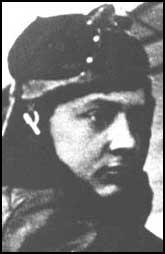George Guynemer

George Guynemer was born in France on 24th December 1894. On the outbreak of the First World War he joined the French Air Service.
At Verdun he was shot down and severely wounded. He returned to the Western Front during the summer of 1916 and flying a Nieuport II at the Battle of the Somme he established himself as France's most outstanding pilot.
Guynemer achieved 53 victories before being shot down and killed on 11th September, 1917.
Primary Sources
(1) Ernst Udet, was one of those German pilots who encountered Georges Guynemar in a dogfight.
We met at the same altitude. As the sun caught it, I saw the other man's machine painted light brown. Soon we were circulating round each other playing for an opening. Below we probably looked like two great birds of prey indulging in spring-time frolics, but we knew it was a game of death. The first man to get behind the other's back was the winner. In the single-seater fighters you could only shoot forward, and if your opponent got on your tail you were lost.
Sometimes we passed so near to each other that I could see every detail of my opponent's face - that is, all that was visible of it below his helmet. On the machine's side there was a Stork and two words painted in white. The fifth time that he flew past me I managed to spell out the word, Vieux. And Vieux Charles was Guynemar insignia. Georges Guynemar had some 30 victories to his credit and I knew that I was in for the fight of my life.
I tried every trick I knew - turns, loops, rolls, sideslips - but he followed each movement with a lightning speed and gradually I began to realise that he was more than a match for me. But I had to fight on, or turn away. To turn away would be fatal.
For eight minutes we had been flying round each other in circles. Suddenly Guynemer looped, and flew on his back over my head. That moment I relinquished hold of the stick, and hammered with both hands at the machine-gun. I missed him and he again passed close over my head, flying almost on his back. Guynemer now knew I was his helpless victim. And then, to my great surprise, he raised his arm and waved to me. Guynemer gave proof that even in modern warfare there is something left of the knightly chivalry of bygone days.
(2) Citation, Chevalier de la Légion d'Honneur (24 December 1915)
Pilot of great gallantry, a model of devotion to duty and courage. During the course of the past six months he (Georges Guynemer) has fulfilled two missions of a special nature requiring the highest spirit of self-sacrifice, and has engaged in thirteen aerial combats, of which two ended in the destruction in flames of the enemy aircraft
(3) Citation, Officier de la Légion d'Honneur (11 June 1917)
Officer of the elite, a fighting pilot as skilful as he is audacious, he (Georges Guynemer) has rendered brilliant service to his country, as much by the number of his victories, as by his daily keenness and ever-growing mastery. Heedless of danger he has become for the enemy, by the sureness of his methods and by the precision of his maneuvers, the most redoubtable adversary of all. On 25 May 1917, he accomplished one of his most brilliant exploits in downing, in one minute, two enemy planes and reporting in the same day two other victories. By all his exploits he contributes to the excitement, courage and enthusiasm of those who, in the trenches, are witnesses to his triumphs. Forty five planes downed, twenty citations, two wounds.
